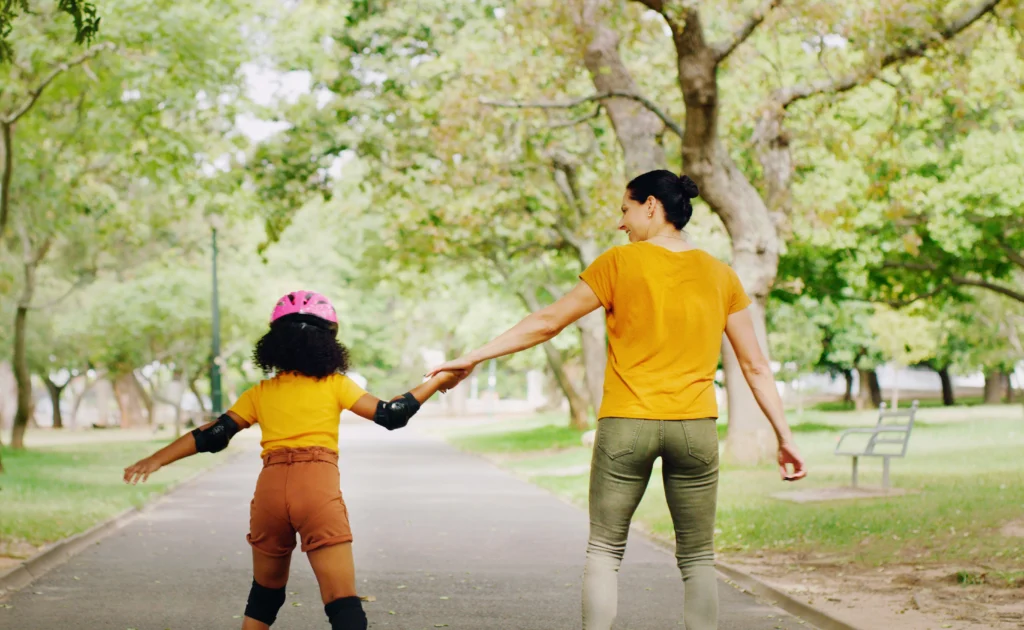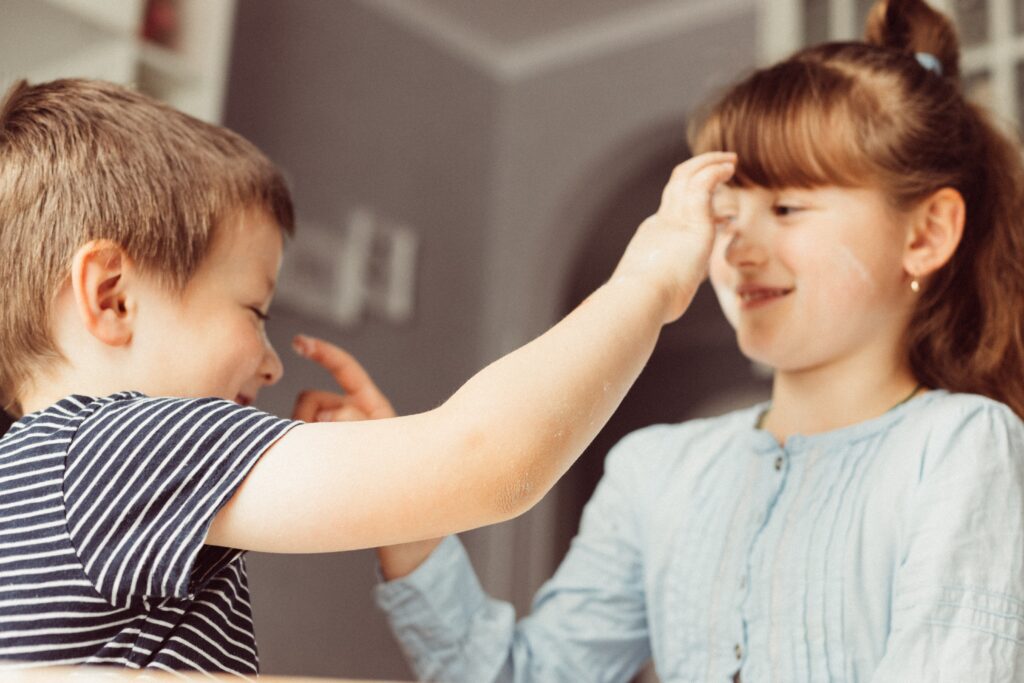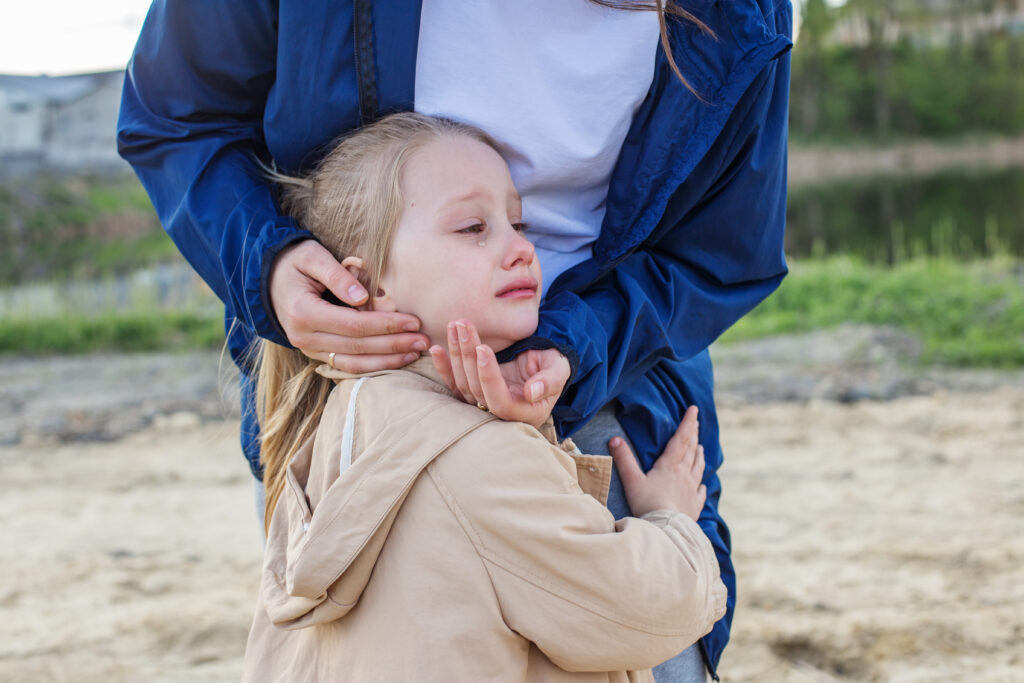Why Parenting Is About You, Not Just Your Child: A Conscious Parenting Perspective

Setting boundaries is an important part of having a healthy relationship and healthy family dynamics, but for many parents this comes with a large amount of shame or guilt when setting and enforcing limits. In a world filled with advice and social pressure on raising a child, it’s easy to think that if you are setting rules or saying “no,” you are being a harsh or unloving parent. However, the conscious parent knows that clear, compassionate boundaries contribute to security, respect, and trust in children, and help children to develop resilience and Emotional Regulation Kids need. Vedangi Brahmbhatt is an experienced Child Development Specialist helping to teach families across the USA how to embrace boundaries without fear or guilt by using mindful parenting strategies. In this blog, learn How to implement conscious parenting techniques at home assertively while being loving and establishing the basis for healthy growth and connection. Recognise Boundaries as Acts of Loving and Caring Setting limits easily lends itself to being viewed as punishment or rejection, when in fact it’s a critical form of nurturing. Boundaries communicate safety and predictability, helping children feel secure. When parents frame limits as acts of protection and love, the guilt that comes with saying “no” lessens. Integrating boundaries into Positive discipline strategies for toddlers helps children understand the “why” behind rules. This approach promotes cooperation over rebellion and supports Holistic Child Development. Practise Nonviolent Communication to Express Boundaries Clearly Clear, empathetic communication is key to setting boundaries without shame. Using Nonviolent Communication techniques, parents can express needs while validating their children’s feelings. This includes calmly stating limits, giving reasons briefly, and offering alternatives. For example, saying, “I want you to be safe, so you need to be in the backyard. Let’s choose some fun toys to play with here,” models respect and offers choice within limits. This helps kids feel heard and reduces power struggles – a true Benefit of mindful parenting for child development. Use Family Meetings and Active Listening Parenting to Build Consensus Including children in discussions of limits through regular Family Meetings promotes ownership and understanding. When kids help set household rules, they’re more likely to respect them. Practising Active Listening Parenting during these discussions enables parents to fully hear children’s perspectives and co-create boundaries aligned with family values. This collaborative process strengthens bonds and minimises guilt parents may feel when imposing limits alone. Conclusion: Boost Your Parenting Power with Compassionate Boundaries Setting boundaries without shame or guilt transforms parenting into a journey of empowerment and love. Clear limits teach safety, responsibility, and Emotional Regulation Kids need for lifelong success. For personalised guidance, consider a consultation with Vedangi Brahmbhatt – an expert in conscious co-parenting and mindful parenting. Her consultations, resources, and even recommendations for the Best Parenting Books offer tools to help families thrive. Don’t forget to follow us on Instagram, and YouTube for ongoing advice and inspiration on Toddler Activities, mindful parenting, and child development. At Vedangi Brahmbhatt, we believe conscious parenting is about boundaries paired with empathy, helping families grow stronger together.
How to Set Boundaries Without Shame or Guilt – A Conscious Parenting Guide

Setting boundaries is an important part of having a healthy relationship and healthy family dynamics, but for many parents this comes with a large amount of shame or guilt when setting and enforcing limits. In a world filled with advice and social pressure on raising a child, it’s easy to think that if you are setting rules or saying “no,” you are being a harsh or unloving parent. However, the conscious parent knows that clear, compassionate boundaries contribute to security, respect, and trust in children, and help children to develop resilience and emotional regulation kids need. Vedangi Brahmbhatt is an experienced Child Development Specialist helping to teach families across the USA how to embrace boundaries without fear or guilt by using mindful parenting strategies. In this blog, learn how to implement conscious parenting techniques at home assertively while being loving and establishing the basis for healthy growth and connection. Recognise Boundaries as Acts of Loving and Caring Setting limits easily lends itself to being viewed as punishment or rejection, when in fact it’s a critical form of nurturing. Boundaries communicate safety and predictability, helping children feel secure. When parents frame limits as acts of protection and love, the guilt that comes with saying “no” lessens. Integrating boundaries into positive discipline strategies for toddlers helps children understand the “why” behind rules. This approach promotes cooperation over rebellion and supports holistic child development. Practise Nonviolent Communication to Express Boundaries Clearly Clear, empathetic communication is key to setting boundaries without shame. Using Nonviolent Communication techniques, parents can express needs while validating their children’s feelings. This includes calmly stating limits, giving reasons briefly, and offering alternatives. For example, saying, “I want you to be safe, so you need to be in the backyard. Let’s choose some fun toys to play with here,” models respect and offers choice within limits. This helps kids feel heard and reduces power struggles – a true benefit of mindful parenting for child development. Use Family Meetings and Active Listening Parenting to Build Consensus Including children in discussions of limits through regular Family Meetings promotes ownership and understanding. When kids help set household rules, they’re more likely to respect them. Practicing Active Listening Parenting during these discussions enables parents to fully hear children’s perspectives and co-create boundaries aligned with family values. This collaborative process strengthens bonds and minimises guilt parents may feel when imposing limits alone. Conclusion: Boost Your Parenting Power with Compassionate Boundaries Setting boundaries without shame or guilt transforms parenting into a journey of empowerment and love. Clear limits teach safety, responsibility, and emotional regulation kids need for lifelong success. For personalised guidance, consider a consultation with Vedangi Brahmbhatt – an expert in conscious co-parenting and mindful parenting. Her consultations, resources, and even recommendations for the best parenting books offer tools to help families thrive. Don’t forget to follow us on Instagram, and YouTube for ongoing advice and inspiration on Toddler Activities, mindful parenting, and child development.
No Fear, No Force: Oh My God, Navigating Power Struggles Without Using Fear Or Force: A Conscious Parenting Guide

Parent-child power struggles are also some of the most stressful situations in family life. Resistance and boundary testing are normal, especially in toddlerhood and early childhood – but fear or force will only serve to increase conflict and harm trust. Wouldn’t there be a softer, better way? The mindful parent recognises that such situations can become moments of connection, learning, and growth with mindful parenting and respectful strategies. We personally have witnessed how parents in the USA can overcome power struggles without any form of punishment or control strategies at Vedangi Brahmbhatt, a reputable Child Development Specialist, to raise healthy, peaceful families. In this post, you will get some must-have tips on how to help your child grow emotionally and manage within your limits in a graceful and compassionate manner. Embrace Open Communication With Family Meetings and Active Listening Nonviolent dialogue in your family is one of the most powerful tools to prevent and stop power struggles. Family meetings help to create a safe environment where everyone can express their ideas – your toddler counts as well as your teen – when it comes to setting expectations and developing solutions. Active listening parenting has nothing to do with just echoing what your child says. Children don’t feel the need to rebel when they feel truly understood. This creates trust and minimises frustration on both ends, supporting the foundation of mindful parenting. Use Positive Discipline Approaches to Toddlers Positive discipline approaches to toddlers are aimed at teaching behaviour, not punishing. This means setting up routines, offering limited options, and having consequences your child can understand. These practices complement the benefits of mindful parenting on child development, helping children learn responsibility and cooperation without intimidation or coercion. Build Emotional Regulation and Resilience Children are still learning about big feelings. It is important to model emotional regulation skills they require. By staying calm in challenging situations and teaching coping techniques such as deep breathing or naming feelings, parents help children learn essential tools. This child development approach is holistic because not only does it ease power struggles in the short-term, but it also equips children for success in social and emotional aspects of life – all central to becoming a conscious parent. Conclusion: Your Journey in Conscious Parenting Begins Today It is an achievable, realistic, and rewarding goal to navigate power struggles without fear or force. Open communication, positive discipline approaches to toddlers, and emotional regulation help create stronger, more conscious family relationships. To receive individual guidance specific to your family’s needs, schedule an appointment with Vedangi Brahmbhatt, one of the most prominent professionals in conscious co-parenting and mindful parenting. Learn about our programmes and resources that empower you to become the conscious parent. Don’t miss following us on Instagram, and YouTube to find out more about mindful parenting and Toddler Activities that nurture growth. Here’s a quick tip: when tension escalates, pause and take three deep breaths before acting – this reset gives you space to respond with empathy and connection. To view our recent press releases, visit this page.
How to Handle Sibling Rivalry with Conscious Parenting

Fights between siblings are a big (and tiring) part of family life. It can be a fight over a toy. It can be a loud yelling match. A lot of parents don’t know when to get in, how to be fair, or how to stop it from getting worse. But here is what I see all the time as a Child Development Specialist These fights don’t mean your children don’t love each other. It shows they’re figuring out how to handle sibling strong emotions with those closest to them, and with the tools of conscious parenting, you can help them develop empathy, speak kindly, and strengthen their bond instead of fighting. Let’s look at how to change these fights into chances for Holistic Child Development through mindful parenting. 1. Don’t Rush to Judge — Show You See Their Feelings First The first thing we want to do as parents is be the judge: “Who did it first?” “Why did you hit him?” But blaming just makes things worse. It can make one child feel unheard. Respond to both with empathy and patience, use Nonviolent Communication to show you see how they feel. Don’t excuse bad and unpleasant behaviour. Try this: “I can see you are both very angry right now. Let’s take a slow breath. Then we can find out what each of you needs.” This small change helps kids feel safe with their feelings. It shows them Emotional Regulation. This is a key part of Holistic Child Development. 2. Use Family Meetings to Build a Close Feel Most of us only talk about our feelings when there’s already a problem, but you can express your feelings each week in the Family Meeting. These planned talks are a great way to use Active Listening Parenting. They give each child a say in the family. You can add easy toddler activities like drawing their feelings or acting out solutions through play. When kids know they can show how they feel in a good way, the bad feelings towards each other will go down over time. Studies say sibling who feel seen and heard at home are kinder to their brothers or sisters. They can learn to resolve disagreements on their own. 3. Teach How to Work Together, Not Just “Share” True sharing develops with maturity; it can’t be forced. Do not just think about what is fair right now. Think about how to make them understand the importance of cooperation. Use Positive discipline strategies for toddlers to show them the way. For example: “Let’s use a timer to take turns with the toy. Then we can talk about how it felt to wait and then to play.” Also, use mindful parenting. See if your feelings about their fights come from your past or stress. When you are calm, your kids learn to be calm in a fight, too. Conclusion: Conscious Co-Parenting for Strong Sibling Ties Fights between sibling aren’t something to fear; they’re part of growing. They are a thing to guide. When we use conscious co-parenting, we stop trying to make kids act a certain way. We try to see why they act that way. We are the conscious parents our kids need. This helps them not just get through the fights, but also do well with their big feelings. Tip: Try a “special time jar.” Let each child pick one thing to do with you each week. This makes their tie to you strong. It cuts down on the fight for your time. Don’t forget to follow us on Instagram, and YouTube for more ideas and help. For new things, click here to see our recent press releases.Are you ready to learn more about how to use conscious parenting techniques at home? Look at our talks for help, our class plans, and some of the Best Parenting Books on the topic at Vedangi Brahmbhatt’s website.
Parenting Without Yelling: Ways That Work

Let’s be real. Parenting isn’t easy, but it can also feel overwhelming. Your child may throw food. They may cry a lot at bedtime. You’re exhausted. They’re exhausted. Sometimes it seems like raising your voice is the only option, but it rarely helps children learn or grow. It just makes things worse. You know there is a better way. As a Child Development Specialist, I work with families who want to nurture confident, emotionally healthy, and happy children. They do not want to yell at or punish you. The good news is that you can nurture your child with compassion while keeping fair rules. It starts with you, a plan, and a few practical approaches that work every day. 1. Pause, breathe, then respond It’s not about never feeling angry, it’s about guiding it into constructive action. A great tool in mindful parenting is to wait before you act. This short time lets you calm down. It stops you from just yelling out. Try this: When you feel the urge to yell, place your hand on your heart and take three deep breaths. You’re not ignoring the problem—you’re simply calming yourself before responding. This shows your child’s emotional regulation. When you do this a lot, your child learns it too. This is a big part of holistic child development. 2. Replace yelling with nonviolent communication. When a child acts out, it is often a cry for help. They may not have the words to say what they need. Act with intention, not with anger. Use Nonviolent Communication to see what they need and show that you understand. Example: Instead of yelling, “Why are you so messy all the time?” Try: “I feel sad when I see toys all over.” I like a clean room. Can we clean up as a team after this game?” This also helps with Active Listening Parenting. Your child will feel truly seen and heard, not judged or embarrassed. 3. Create rituals that reinforce connection and boundaries Ways of stopping problems are as important as ways to fix them. One easy but strong tool is a family meeting. This is a check-in each week. Everyone in the home can share their feelings, express their worries, and talk about the positives. This helps with conscious co-parenting. It shows kids how to work as a team to fix problems. Make routines fun by including simple, enjoyable activity sets for your toddler. This gives your child a plan and a feeling that they are part of the family. A child who feels close to you is less likely to “act out.” A study shows that when you are in tune with a young child’s feelings, they grow up with better self-control. These are the outcomes we hope to see from positive discipline strategies for toddlers. Conclusion: Yelling Isn’t the Only Option Yelling doesn’t make you a bad parent, it means you’re human. But if you’re reading this, you’re already taking the first step toward change. You can be the conscious parent your child needs. Tip: Develop a ‘calm plan’ together, so when emotions are out of control, you both know it’s time to pause. Only after you’re both calm, you can talk things through. This plan gives you both a tool to use when feelings seem uncontrollable. Remember this: you are not on your own. We can help you. Our conversations are guided by the ideas of Conscious Co-Parenting NJ. We also draw on proven strategies from some of the best parenting books available. Don’t forget to follow us on Instagram, and YouTube for more good ideas. For new news, click here to see our most recent press releases.
How to Really Listen to Your Child: The Art of Conscious Communication

Are you ever busy with a job—like making food or work—when your child comes to tell you a big thing? You nod and say “uh-huh,” but their eyes stay on you. They wait for you to really look at them. That look is a sign. Your child does not just want to talk. They want to be heard. As a Child Development Specialist, I see now that one of the best gifts we can give our kids is our full time and care. To give your time and care is not just to be in the same room. It is to join in with Active Listening Parenting, show you see their feelings, and use what I call Conscious paranting. Here, we will look at how to be the conscious parent. A parent who listens with care, gives kind words back, and builds a life of trust with their child. 1. Listening Is More Than Hearing Hearing just happens. Listening is work. It is to use your ears, eyes, and heart. When your child talks, do you look at them? Do you stop what you do? Do you show that you see how they feel? Like this: “You look very sad your toys fell. That must feel bad.” That is Nonviolent Communication. You show you see their feelings. You do not judge or fix them. This is a key part of mindful parenting. With it, your time and care mean more than being right. Life shows that kids who feel heard have a good hold on their feelings. They can also work out hard things as they grow up. This is called Emotional Regulation. 2. Ask, Don’t Tell When your child tells you a thing—a big thing—you may want to give help or fix it. But most of the time, they just want you to know how they feel. Try to ask questions that need more than a yes or no: This lets them talk more. It helps them find words for their feelings. This is a main part of Holistic Child Development. In Family Meeting times I have led, parents who do this all the time see a big change. Their kids talk more and end fights in a good way. It is also a key rule for conscious co-parenting like we teach at Vedangi Brahmbhatt. 3. Make Times to Talk Some of the best talks can be had in day-to-day life. It can be in the bath, in the car, or when you make food. These are good times for Toddler Activities. You can add set times to check in. One way is to ask for one good thing and one hard thing from the day. These small habits can help all kids share more. They show the benefits of mindful parenting for child development and help kids feel safe. Tip: Make a “listen time” for 5 minutes each day. Your child talks and you just listen. Do not stop them, give help, or do other work. It is a very good thing to do. Real-Time Insight: A new look at life in 2024 shows that homes that use listening and kind talk each day have far less bad ways of acting out. This shows how to implement conscious parenting techniques at home is not just an idea—it brings a very big change. Conclusion: A Tool for Life Kids do not need us to know all the things. They need us to be there for them. To make space for their big questions, what they fear, and their joy. When we use conscious communication, we build trust. We help them feel good about who they are. We help them be strong inside. Parenting Tip: When feelings are big, try to say their words back to them. It shows you love them and are with them. It helps them to keep on with their story. Don’t forget to follow us on Instagram, and YouTube for more on mindful parenting and conscious communication. For the latest news, click here to view our recent press releases.
Mindful Parenting: How to Be Present in Everyday Moments

We live in a world that glorifies multitasking—juggling work emails, dinner plans, and endless screen scrolling. Yet where does that leave our relationships with our children? The magic often lies in simple, shared moments: the feel of toothpaste on a toothbrush, the sound of giggles during “toddler activities,” or the warmth of a bedtime story. These fragments, when fully experienced, shape lifelong memories and foster deep connection. As a Child Development Specialist, I’ve witnessed how intentional presence transforms not just a child’s day, but their emotional well-being long-term. Through mindful parenting, you can cultivate a responsive, compassionate, and grounded relationship with your child. Let’s explore how to infuse everyday life with mindful connection. 1. Anchor in the Moment with Routines & Rituals Routine isn’t boring—they’re anchors for emotional security. Simple rituals give space for presence and help frame your day with intention. a. Shared Toddler Activities Turn daily tasks into moments of connection. Invite your child to help rinse vegetables or water plants. Let them feel the cool water on their fingers and describe the sensation. These small gestures reinforce presence and respect. b. Meaningful Bedtime Rituals Dedicate just five minutes each night to talk about the day’s highlight and challenge. Use Active Listening Parenting: “What was the best part of your day?” This encourages emotional awareness and strengthens trust. c. Use Family Meetings Weekly check-ins can be golden. Ask open-ended questions like, “How did we show kindness this week?” or “What challenge can we help each other with?” These meetings reinforce empathy, accountability, and belonging. 2. Respond with Awareness, Not Reactivity When a child spills juice or throws a tantrum, it’s easy to react. But mindful parenting teaches us to pause and breathe—no matter how small the moment. a. Breathe Before You Speak Pause and take three deep breaths. This small act helps you switch from autopilot to awareness, avoiding harsh words or scolding, and instead choosing empathy. b. Validate Emotions Acknowledge the feeling first: “I see the juice spilled and you’re upset.” Then, offer guidance: “Let’s clean it up together.” This blends emotional support with appropriate boundaries—a key part of Positive discipline strategies for toddlers. c. Practice Nonviolent Communication Use neutral language like “I feel…” statements instead of blaming. “I feel worried when you climb on the table because you could get hurt.” This helps children understand the impact of their actions without shame. 3. Cultivate Connection Through Intentional Habits Presence isn’t a one-time event; it’s a tapestry woven through intentional habits. a. Digital-Free Moments Set aside tech-free zones—like dinner tables or evening walks—to fully engage with each other. Face-to-face eye contact enhances connection and helps encourage Emotional regulation kids skills. b. Model Self-Awareness Narrate your feelings aloud: “Mommy feels frustrated. I’m going to pause and breathe.” Such modeling teaches your child it’s safe to express and regulate big feelings—another benefit of mindful parenting. c. Learn Together Dive into a Best Parenting Books with your partner. Discuss topics like Holistic child development, or join our LMS to practice how to implement conscious parenting techniques at home. Growth is richer when shared. Real-Time Insight A 2023 study from the University of Washington found that brief daily moments of connection—even five minutes—can improve child behavior and parent–child closeness by over 25%. The secret isn’t perfection; it’s consistency. “Presence” isn’t about flawless teaching—it’s about showing up fully 5% more often. Over time, those ripples ripple outward. Conclusion: Begin with Small Shifts, Reap Big Rewards Mindful parenting isn’t a grand gesture—it’s a commitment to presence in everyday life. Start small: a shared snack, a heartfelt question, or a moment of breathing. These are the building blocks. Over time, they become culture. Tip: Pick one daily anchor—like a bedtime chat or a morning hug ritual—and stick with it for a week. Notice how your child’s spirit shifts. And celebrate that change. To deepen your journey, join our thriving community. Don’t forget to follow us on Instagram, and YouTube for more insights and tools. For the latest news and updates, click here to view our recent press releases.
How to Stay Calm When Your Child Is Having a Meltdown

There’s nothing quite as challenging—or humbling—as staying composed when your child is mid-meltdown in the middle of the grocery store. Whether it’s a spilled snack, a denied toy, or “just because,” meltdowns test even the most patient caregivers. But how we respond in these moments matters deeply—not just for our kids, but for our own emotional well-being. As a Child Development Specialist, I’ve seen that these high-stress moments are also powerful opportunities. Opportunities to model emotional regulation, create connection, and embody what it means to be the conscious parent. Let’s talk about how you can stay grounded—even when everything feels like it’s unraveling. 1. Regulate Yourself First: Your Calm Is Contagious Before you can guide your child through their storm, you must anchor yourself. Children subconsciously borrow our nervous systems—if we’re anxious, they escalate. If we stay calm, they begin to regulate. Incorporate mindful parenting techniques like deep breathing or repeating calming mantras such as “My child is having a hard time, not giving me a hard time.” This pause allows you to respond, not react. And yes, it’s okay to take a moment for yourself. Step away briefly (when safe), close your eyes, breathe deep, and ground your feet. You’ll return more present and composed. 2. Empathy Over Explanation When a child is in meltdown mode, logic won’t land. Instead of trying to explain or fix, lean into connection. Get down to their eye level and use Active Listening Parenting tools: “I see you’re really upset. I’m here with you.” This nonjudgmental presence helps your child feel seen and safe. It’s also a practice rooted in Nonviolent Communication, which is key to nurturing trust and co-regulation. Think of these moments as micro Family Meetings—they’re not scheduled, but they’re full of emotional data. They tell you what your child is struggling with, and what they need from you emotionally, not behaviorally. 3. Set Boundaries with Compassion Being calm doesn’t mean being permissive. Children thrive with clear, loving limits. Use positive discipline strategies for toddlers such as “I won’t let you hit, but I’ll help you with those big feelings.” It’s a dance between empathy and boundaries. The goal is to stay connected while guiding. This approach supports Holistic Child Development—meeting their emotional, cognitive, and social needs in the moment. Over time, these small interactions shape your child’s ability to handle frustration, communicate clearly, and develop healthy coping skills. Real-Time Research and Stats According to a 2023 study by the American Psychological Association, children whose parents consistently respond with calmness and connection during emotional outbursts are 60% more likely to develop strong self-regulation skills by age 5. Practicing how to implement conscious parenting techniques at home not only builds emotional safety but also decreases behavioral problems over time. Conclusion: Choose Connection Over Control Parenting isn’t about perfection—it’s about presence. Staying calm during your child’s meltdowns isn’t easy, but it is deeply impactful. Every moment you choose connection over control, empathy over reaction, you lay the foundation for lifelong emotional intelligence. Tip: Create a calm corner at home—a cozy space with soft lighting, favorite books, or sensory items where your child can go to reset when things feel big. Don’t forget to follow us on Instagram, and YouTube for more insights and expertise. For the latest news and updates, click here to view our recent press releases.
Breaking Generational Parenting Patterns: A Path to Healing

Parenting is a journey intertwined with chapters from past generations. Many of us unknowingly repeat habits—both loving and limiting—that were passed down to us. From strict discipline to emotional suppression, these generational patterns can cling to us, affecting our children and family legacy. But here’s the hopeful truth: awareness and intentional change can create ripples of healing that enrich generations to come. In this post, we’ll explore three actionable strategies to break these cycles, introducing you to a journey of transformation rooted in mindful parenting and conscious co-parenting. 1. Understand the Roots of Your Patterns Reflect on Family History Begin with self-awareness. Consider your upbringing—were emotions openly expressed, or were they suppressed in favor of stoicism? Did praise pour forth, or did criticism dominate? Identifying these ingrained behaviors helps illuminate the areas needing change. 2. Implement Conscious and Mindful Parenting Practices Once you recognize inherited patterns, intentional change can begin: a. How to implement conscious parenting techniques at home b. Embrace Nonviolent Communication c. Positive direction with positive discipline strategies for toddlers d. Practice benefits of mindful parenting for child development 3. Build a Supportive System Around You Transforming generational patterns doesn’t happen in a vacuum—it thrives with support and guidance. a. Engage with a Child Development Specialist b. Lean into conscious co-parenting c. Equip Yourself with Expert Resources d. Practice Regular Family Meetings Real-Time Impact: What the Research Shows Conclusion Breaking generational parenting patterns is courageous work—but deeply rewarding. By recognizing inherited habits, embracing conscious parenting, and building a supportive framework, you’re not just guiding your child today—you’re setting a generational path of healing. Tip: Start small—dedicate five minutes each evening to discuss highs and lows with your child. Choose empathy, stay curious, and remain present. For more tools to support your journey, don’t forget to follow us on Instagram, and YouTube.For the latest news, research, and expert features, click here to view our recent press releases—and stay empowered on your path as the conscious parent.
The Difference Between Traditional and Conscious Parenting

“Because I said so.” For many of us, those words echo in memory—firm, final, and unquestioned. Traditional parenting, rooted in obedience and authority, has long been the go-to model for raising children. But as our understanding of emotional health, communication, and child psychology evolves, so does the way we parent. Welcome to the world of the conscious parent—a paradigm where empathy, emotional awareness, and presence take center stage. At Vedangi Brahmbhatt, we guide families toward more connected and intentional parenting practices. This article breaks down the core differences between traditional parenting and conscious parenting, helping you decide what resonates best for your family’s journey. 1. Control vs Connection Traditional Parenting: Traditional parenting often operates on a top-down model, where the parent is the authority and the child is expected to obey. Discipline often involves rewards for good behavior and punishments for bad behavior, aiming to manage behavior through external control. This approach can result in compliance—but sometimes at the cost of emotional expression or internalized shame. Conscious Parenting: Conscious parenting shifts the focus from control to connection. Rather than trying to manage a child’s behavior, conscious parents try to understand the emotions beneath the behavior. It’s about addressing the root cause, not just the surface response. By practicing active listening parenting and tuning into your child’s emotional needs, you create a safe, nurturing space where growth happens through mutual understanding—not fear. This style of parenting is deeply aligned with mindful parenting, which prioritizes being present and emotionally responsive rather than reactive. Children raised in this environment are more likely to develop emotional regulation skills, fostering long-term mental wellness. 2. Obedience vs Emotional Awareness Traditional Parenting: In traditional models, a child’s obedience is often viewed as the benchmark for successful parenting. There is an emphasis on respect for authority, often without the same weight placed on understanding emotions or validating the child’s perspective. While structure is important, this approach can sometimes suppress a child’s voice, leaving them less equipped to navigate emotions or advocate for themselves. Conscious Parenting: The conscious parent believes that emotions are information, not problems. Children are encouraged to express their feelings, ask questions, and participate in conversations about limits and consequences. This doesn’t mean a lack of structure—boundaries still exist, but they’re rooted in compassion and communication. Using tools from nonviolent communication, parents teach children how to express needs respectfully while also listening to others. This lays a strong foundation for holistic child development, where emotional intelligence and self-regulation are key outcomes. If you’re co-parenting, embracing conscious co-parenting (like that modeled in Conscious Co-Parenting NJ) ensures that both caregivers support the child’s emotional world consistently—no matter how many households they live in. 3. Behavior Correction vs Inner Growth Traditional Parenting: Traditionally, parenting revolves around shaping a child’s behavior to meet social expectations—be polite, don’t talk back, don’t cry in public. Mistakes are often met with consequences, and success is typically measured by external achievement or compliance. This can create children who are “well-behaved” but who struggle with emotional resilience, self-awareness, or authentic expression. Conscious Parenting: In contrast, conscious parenting sees parenting as a mirror. Children reflect our triggers, our fears, and our unmet needs. Rather than correcting them, we pause to explore what’s coming up in us. By focusing on internal growth and healing, parents model what it means to own mistakes, manage stress, and navigate difficult emotions. This vulnerability invites children to do the same—without fear of rejection or punishment. That’s why practices like family meetings, which encourage open discussion and shared decision-making, are often used in conscious homes. These conversations model accountability, empathy, and healthy conflict resolution. And for younger children, even routine toddler activities—like putting on shoes or sharing toys—become opportunities to teach autonomy and emotional literacy using positive discipline strategies for toddlers. Final Thoughts: It’s Not Either/Or—It’s Evolve and Integrate Traditional parenting gave many of us structure, values, and safety. But conscious parenting builds on that foundation by weaving in emotional intelligence, empathy, and reflection. It’s not about discarding the old—it’s about evolving into something more complete, more connected, and more human. You don’t have to get it perfect. Conscious parenting is not about being calm 100% of the time—it’s about being aware, curious, and willing to grow. And at Vedangi Brahmbhatt, we’re here to walk that journey with you. Parenting Tip: Before correcting your child’s behavior, try this 3-step pause: This brief moment of awareness can turn a power struggle into a breakthrough. Stay Connected: For more insights, tools, and heart-led parenting content: 👉 Follow us on Instagram, and YouTube For the latest news and updates, click here to view our recent press releases.

